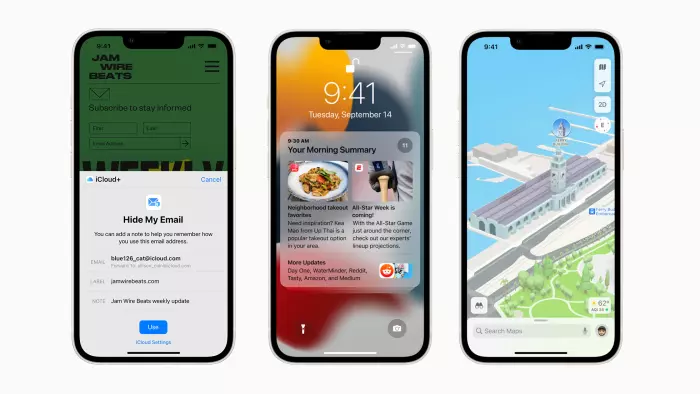In June, Apple dropped some news which caused quite a stir in the marketing community. As part of its planned roll-out of its latest operating system, iOS 15, it would be introducing new privacy features which would provide users with greater visibility and control over how apps use their data.
This represents the latest step from Apple in its mission to deliver enhanced privacy protection to its user base and is in line with broader industry trends in this area. However, it was the impact of these changes on email marketing specifically that caused this announcement to ruffle a few feathers.
There are three key updates as part of the iOS roll-out which will affect email marketing:
- Email privacy protection removes the ability for senders to accurately track open rates.
- Private relays will hide users’ IP address while browsing the web and opening emails.
- “Hide my email” enables users to “mask” their real email address with a dummy one.
Each of these updates will have an impact on email marketing. Let me explain why.
Email marketing has long been one of the most effective channels available to marketers. The ability to send highly personalised and targeted messages at relatively low cost makes email a channel which is accessible and easy to implement for businesses of all shapes and sizes.
Another aspect of email marketing which makes it so appealing is the ability for marketers to track how their audience are engaging with messages. All modern email marketing platforms, such as Mailchimp, have long enabled marketers to monitor when someone opens an email or clicks on a link. When used wisely, this provides a valuable source of feedback, which can be used to shape and improve an email marketing strategy, optimise content and, ultimately, deliver a better subscriber experience. This, in turn, translates to an uplift in engagement and response rates.
How email marketing tracking works
There are numerous metrics that email marketing platforms track. Here’s a quick explanation of how three of the most commonly used metrics work:
Bouncebacks – When an email is rejected by a recipient’s mail server, an automated message is sent back to the sender informing them that delivery has failed. In marketing language, this is called a bounceback and is used to help senders maintain list hygiene by removing or suppressing non-deliverable emails from a mailing list.
Opens – Email platforms track opens by embedding an invisible single-pixel image in every email that is sent. When the recipient opens their email, this image is downloaded, registering as a “hit” on the hosting server. Every email sent includes a unique tracking pixel address, which means the email platform can determine when a particular recipient has opened their email. When this pixel is downloaded, the recipient’s IP address is also recorded, which can be used to determine the approximate geographic location of that reader.
Clickthroughs – Links in emails sent from a marketing platform are usually redirected through a tracking URL. This redirect process happens almost instantly and usually isn’t noticeable to the recipient, but it lets marketers know when a subscriber has clicked on a specific link.
Another important interaction event which all reputable email marketers should be tracking is unsubscribes. In order to comply with the law and email platform policies, every marketing email must contain a functioning unsubscribe link. This ensures that recipients have a way of easily removing themselves from an email list and is one of the things that separates legitimate email marketing practices from spam.
How Apple’s iOS 15 privacy updates impact email marketing tracking
Perhaps the most important impact to understand is that iOS15 will block opens from being tracked accurately. The reason for this is that all images embedded within an email, including tracking pixels, will be preloaded by Apple before hitting the user’s inbox.
The net effect of this for marketers will be that any subscribers opening emails on an iOS 15 device will automatically show as having opened their email, even if they haven’t really done so. Aside from the obvious impacts on campaign reporting accuracy, this also has implications for subject line split testing, automated email flows that use open tracking to adapt messaging based on engagement, and list cleansing – the practice of isolating and archiving inactive subscribers from a list.
Because emails will be routed through a private relay, this also means that marketing platforms will no longer be able to determine the IP addresses of their subscribers. This affects geo-location reporting and device analytics, meaning that marketers will not be able to tell where these emails were opened and on which operating system.
And lastly, iOS 15’s “Hide my email” feature provides users with the option to generate a unique “dummy email address” for use when signing up to an email list. Emails sent to these generated addresses will be routed to the user’s primary address but dummy addresses can be deleted at any time, which provides users with more control over their inbox and the ability to hide their personal address from marketers.
How should marketers respond to these changes?
Understandably, this news initially caused strong reactions from the marketing community, ranging from mild consternation to full-blown panic. Was this the death knell for email marketing tracking? Will other platforms follow suit? Is email still going to be a viable marketing channel?
But as the dust settled and marketers began to take stock of the impacts, it became apparent that this isn’t the end of the world. In fact, this may even prove to be a positive change for everyone, even marketers, because it promotes a shift in thinking and puts more emphasis on the practices and measures that really matter.
While open rates can provide some useful clues about which subject lines work best, they’ve never been 100% reliable and can be misleading, especially when viewed in isolation. Just because someone has downloaded the images in your email doesn’t necessarily mean they’ve read it or engaged with your content. What’s really important is what people do with your email once they open it. Clickthroughs and post-click metrics can tell you much more about the success of your email program than opens alone.
With that said, there are some steps I would recommend taking immediately to help prepare for these changes and adapt.
Measure the impact now
Many email platforms provide some form of device-analytics report which shows you the breakdown of operating systems being used to read your emails. Check your report as soon as possible to determine the rough percentage of your email list that uses an iOS device. For most of our clients, this figure ranges from 10% to 30%. Once you know this figure, you can use it to estimate the impact the iOS roll-out may have on your open rates.
If possible, you may also wish to place known iOS users into their own segment or tag them so that you can isolate them from your reports and give yourself a clearer picture of true open rates once the iOS roll-out is complete.
Clean your lists
Every successful email marketer should be regularly cleaning or “pruning” their lists to remove inactive subscribers. This is important for multiple reasons. It helps to preserve your deliverability by reducing the risk of spam complaints, can save you money by cutting down on your contact count, and gives you a clearer view of engagement rates by focusing on active subscribers.
Now is a good time to clean up your list while you still have a (mostly) accurate view of open rates. However, you should always consider the wider picture when defining engagement, and in the post-iOS 15 world, this will become all the more crucial. Don’t just look at open rates. Look at clicks, website logins, purchases and app interactions and use these in combination to form your own definition of active versus inactive.
Once you’ve got a list of inactive contacts, consider sending them one or more targeted campaigns giving them the opportunity to renew their subscription before you remove them from your lists.
Rethink your metrics
Rather than focusing on open rates, you should be adopting a more holistic approach to measuring success with your email marketing. Your reporting model should incorporate a combination of multiple metrics, including list growth rates, clickthrough rates, conversion rates, bounce rates, unsubscribe rates and complaint rates.
In addition to this, use performance measures which extend beyond emails to provide a more complete view of customer engagement. These include offline purchases, website views, account logins, app engagement, and SMS engagement.
The combination of these metrics will tell you much more about the success of your emails than open rates ever could.
Review your content strategy
Creating and delivering relevant, quality content to your subscribers has always been the foundation of email marketing success. It is now more important than ever to ensure that you have a clear view of what content will attract subscribers and keep them engaging with your emails.
Review your past reports to help build a picture of what content resonates best with your audience. Open rates can help you to understand what subject lines work best, while click rates can give you a view of which kind of messaging styles, creative and offers tend to drive the most action.
Armed with this insight, review your content strategy to ensure that it aligns with what drives engagement and conversions.
Far from heralding the death of email marketing, the upcoming iOS 15 roll-out presents marketers with an ideal opportunity to revamp and refine their email strategy, adopt a more holistic, customer-centric approach to tracking, and achieve even better results from the channel.
Nick Whiteacre is founder and managing director of Calibrate Marketing, a multi-channel digital agency which helps New Zealand businesses to grow faster through data-powered digital marketing, including conversion-focused website design, email marketing and automation, search marketing, digital advertising, lead generation and more.










